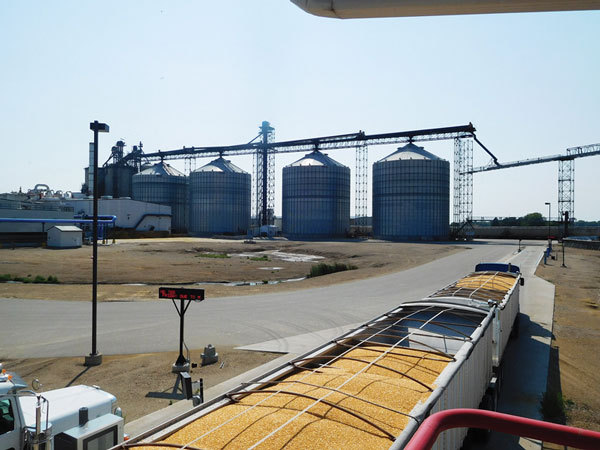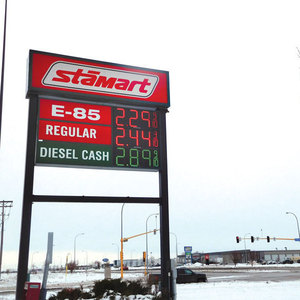Unexpected Incentive



PHOTO: LISA GIBSON, ETHANOL PRODUCER MAGAZINE
January 18, 2018
BY Lisa Gibson
A common argument among opponents of ethanol is that renewable identification numbers (RIN) can drive fuel prices higher for consumers. A higher RIN, they say, increases the price of fuel blended with ethanol. Ron Lamberty, senior vice president of the American Coalition for Ethanol, has a different theory. To back it up, he points to lower net prices of higher ethanol blends at the pump, in the face of RIN value spikes.
Back in October, when the U.S. EPA rejected petitions to move the point of obligation, and rejected requests to allow RINs on exported gallons, RIN values increased. But instead of prices at the pump increasing, prices of higher ethanol blends at many stations sank. Why? Put simply, ethanol producers were reducing the prices on the RINless ethanol they sold, allowing retailers to pass along those savings to their customers.
Glacial Lakes Energy in South Dakota, Lamberty cites, sold its RINless denatured ethanol for just 30 cents per gallon, and Absolute Energy in Iowa was offering RINless E85 for 55 cents. When ethanol is sold RINless, the RIN is retained by the blender and its value is subtracted, leaving a low net fuel price.
“There are a growing number of retailers buying RINless ethanol directly from producers like Absolute Energy and GLE,” Lamberty says. “The idea that small, independent station owners can’t benefit from RINs just isn’t true. Owners of single stores and small chains are the primary buyers of RINless ethanol and E85.”
The Price
Brad Schultz, director of commodities and risk management for Glacial Lakes Energy, confirms that GLE’s RINless gallons go to local retailers, and higher RIN values decrease GLE’s price on those gallons. The 30-cent price tag in October is the lowest one GLE has ever attached to its RINless gallons, he says.
If ethanol is selling at $1.35 per gallon and a RIN is worth 85 cents, that RINless price becomes 50 cents. When 50-cent ethanol is blended into gasoline priced at $1.75 per gallon to produce E85, “You can knock the price of fuel down pretty fast,” Lamberty says. At that price, a gallon of E85 consists of about 27 cents worth of gas and 43 cents of ethanol. With freight and taxes, the wholesale on that gallon would be $1.25 to $1.30. “Compare that to gas being sold at $2.25 to $2.30. … If you’re getting a lower price for product, use that lower price to catch people’s attention and get them to try a higher ethanol blend.”
Schultz says GLE has been selling RINless ethanol for about three years. “After numerous discussions with local retailers, what we found out was it was difficult for retailers to pass the full value of the RIN on to the consumer because they had a very hard time marketing their RINs. … We came up with a program where we would sell ethanol to local retailers and keep the RIN, and that would allow us to sell RINless ethanol as cheap as 30 cents a gallon.”
Retailers struggled to manage the risk in the market on RINs, Schultz says. “If a RIN were worth 70 cents, they weren’t always comfortable valuing their ethanol and the RIN within that 70 cents. They didn’t want to take the risk that they would be able to get it sold at 70. The ethanol producer is better positioned to aggregate the RINs from a variety of retailers in the area, and it’s easy for us to manage that risk and get them marketed.”
Schultz says he agrees with Lamberty’s analysis. “A higher RIN price can result in cheaper RINless ethanol, which would certainly make the higher blends more competitively priced.”
The RINless ethanol market’s ability to lower net prices on higher blends is fairly regional, though, Lamberty says. “Because the ethanol producers, which are mostly Midwest located, are the ones that are driving it.” It’s not about making more money, he says. “It’s kind of philanthropic on their side.”
Indeed, Schultz says selling cheap RINless gallons helps encourage ethanol use. “It’s part of doing our share to promote higher blends.”
Blending In
If a refiner doesn’t blend ethanol into gasoline on its own, it must pay someone else to do it. For retailers, Lamberty says, blending for refiners is an opportunity for new equipment. “Because some refiners either can’t or won’t blend their own fuel, this market has emerged of independent retailers and wholesalers who will blend the fuel and then sell the RINs, directly or indirectly, to those refiners who need them to comply with the Renewable Fuel Standard.” That extra margin reduces the price of the fuel so more can be sold. “Retailers usually make a little more margin on the ethanol blends and that helps them pay for the equipment they need to sell it.”
Most terminals will sell product with or without RINs, but the price is often the same as gallons with RINs, Lamberty says. “Refiners don’t want it to be attractive, necessarily, because if people are blending their own ethanol, refiners aren’t getting the RINs and that just makes it more difficult for them. They are blending and passing on some of the RIN value at some terminals, but not enough.”
More ethanol being sold means more available RINs, which would decrease the RIN value, Lamberty says. “The ironic thing is if oil companies who are short of RINs really wanted to fix things, what they would do is encourage people to use E15 or E85 to sell more ethanol because then there would be excess RINs, and when there’s excess RINs in the market, people don’t have to pay very much for them.”
A main goal of ACE has been to reach out to wholesalers and retailers to talk about the math surrounding RINs, Lamberty says. “It’s an opportunity for them if they understand how RINs work.
“Our focus has always been to explain to retailers how they can make more money selling our product. In the long run, you can do all kinds of programs; you can buy them pumps. … But the guys who are going to sell your product long term and promote it themselves are going to be the people who realize that they’ve got a niche, that they’ve got a product that they’re going to use to make more money and get more volume. That’s what we’re able to do with RINs.”
Author: Lisa Gibson
Managing Editor, Ethanol Producer Magazine
701.738.4920
lgibson@bbiinternational.com
Advertisement
Advertisement
Related Stories
CARB on June 27 announced amendments to the state’s LCFS regulations will take effect beginning on July 1. The amended regulations were approved by the agency in November 2024, but implementation was delayed due to regulatory clarity issues.
SAF Magazine and the Commercial Aviation Alternative Fuels Initiative announced the preliminary agenda for the North American SAF Conference and Expo, being held Sept. 22-24 at the Minneapolis Convention Center in Minneapolis, Minnesota.
Saipem has been awarded an EPC contract by Enilive for the expansion of the company’s biorefinery in Porto Marghera, near Venice. The project will boost total nameplate capacity and enable the production of SAF.
Global digital shipbuilder Incat Crowther announced on June 11 the company has been commissioned by Los Angeles operator Catalina Express to design a new low-emission, renewable diesel-powered passenger ferry.
International Air Transport Association has announced the release of the Sustainable Aviation Fuel (SAF) Matchmaker platform, to facilitate SAF procurement between airlines and SAF producers by matching requests for SAF supply with offers.
Upcoming Events










